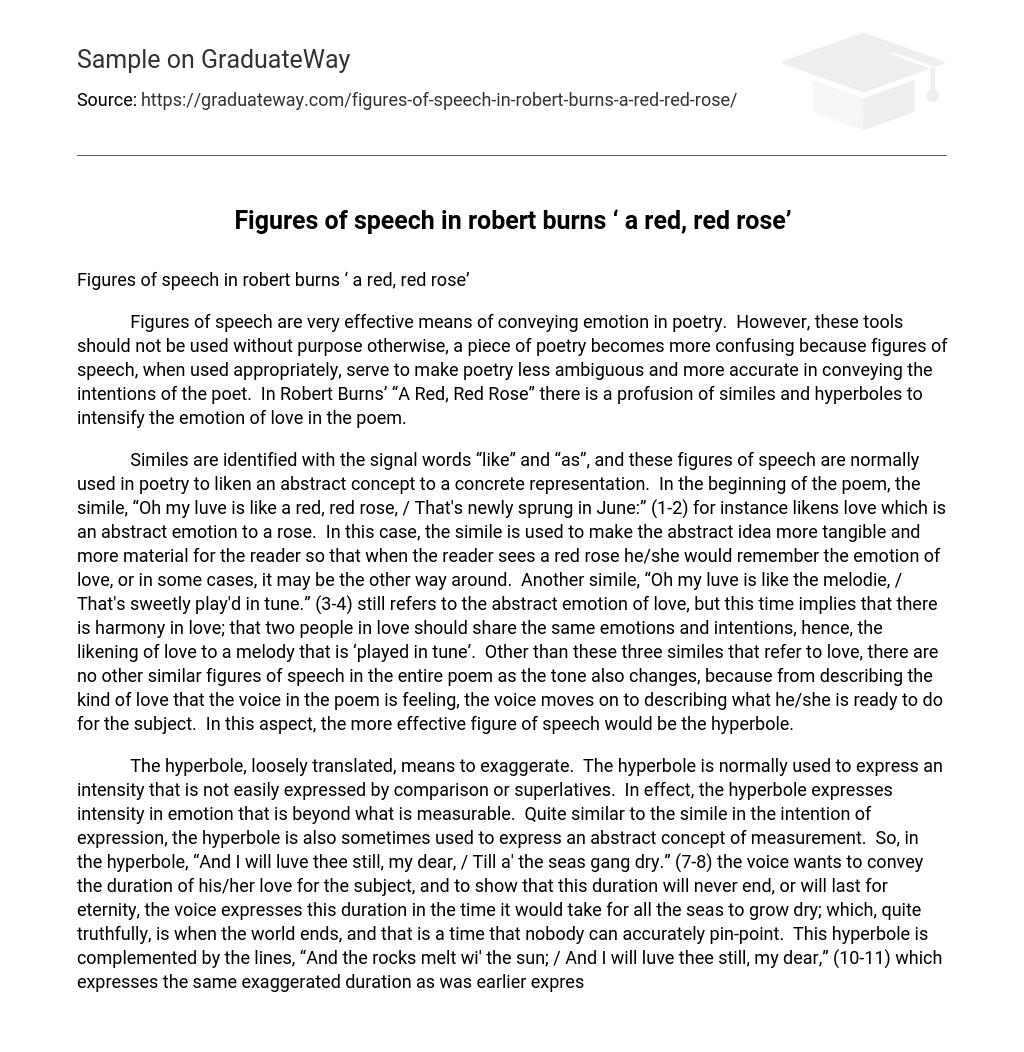Figures of speech are very effective means of conveying emotion in poetry. However, these tools should not be used without purpose otherwise, a piece of poetry becomes more confusing because figures of speech, when used appropriately, serve to make poetry less ambiguous and more accurate in conveying the intentions of the poet. In Robert Burns’ “A Red, Red Rose” there is a profusion of similes and hyperboles to intensify the emotion of love in the poem.
Similes are identified with the signal words “like” and “as”, and these figures of speech are normally used in poetry to liken an abstract concept to a concrete representation. In the beginning of the poem, the simile, “Oh my luve is like a red, red rose, / That’s newly sprung in June:” (1-2) for instance likens love which is an abstract emotion to a rose. In this case, the simile is used to make the abstract idea more tangible and more material for the reader so that when the reader sees a red rose he/she would remember the emotion of love, or in some cases, it may be the other way around. Another simile, “Oh my luve is like the melodie, / That’s sweetly play’d in tune.” (3-4) still refers to the abstract emotion of love, but this time implies that there is harmony in love; that two people in love should share the same emotions and intentions, hence, the likening of love to a melody that is ‘played in tune’. Other than these three similes that refer to love, there are no other similar figures of speech in the entire poem as the tone also changes, because from describing the kind of love that the voice in the poem is feeling, the voice moves on to describing what he/she is ready to do for the subject. In this aspect, the more effective figure of speech would be the hyperbole.
The hyperbole, loosely translated, means to exaggerate. The hyperbole is normally used to express an intensity that is not easily expressed by comparison or superlatives. In effect, the hyperbole expresses intensity in emotion that is beyond what is measurable. Quite similar to the simile in the intention of expression, the hyperbole is also sometimes used to express an abstract concept of measurement. So, in the hyperbole, “And I will luve thee still, my dear, / Till a’ the seas gang dry.” (7-8) the voice wants to convey the duration of his/her love for the subject, and to show that this duration will never end, or will last for eternity, the voice expresses this duration in the time it would take for all the seas to grow dry; which, quite truthfully, is when the world ends, and that is a time that nobody can accurately pin-point. This hyperbole is complemented by the lines, “And the rocks melt wi’ the sun; / And I will luve thee still, my dear,” (10-11) which expresses the same exaggerated duration as was earlier expressed. Surprisingly, while the poem is pervaded with more similes and hyperboles than normal, another figure of speech appears in the next line, the metaphor. The metaphor is, very simply, a simile without the ‘like’ and the ‘as’. The purpose of this particular figure of speech is to express a contrast or a parallel instead of a likeness. The line, “While the sands o’ life shall run.” (12) is a metaphor that expresses how time contrasts with sand that steadily and regularly trickles. Time acts in the same way, and so the metaphor is accurate; it being true on both the literal and the metaphorical level. The poem, as expected, ends with another hyperbole in the lines, “And I will come again, my luve, / Tho’ it were ten thousand mile!” (15-16) Here now, one sees that the hyperbole no longer expresses duration but distance. The voice exaggerates the distance to show that he/she does not care how far he/she must go to be together with his/her loved one.
The textual evidence in this piece very accurately demonstrates the effects of similes, hyperboles, and metaphors in poetry. In this particular piece by Robert Burns, the figures of speech used served to intensity the emotion of love by concretizing it and by expressing the boundlessness of the actions that a person in love would go through in the interest of his/her loved one.
Works Cited
Burns, Robert. “A Red, Red Rose.” Poemhunter.com. N.p., 2003. Web. 27 July 2010.
;http://www.poemhunter.com/poem/a-red-red-rose/;.
;





